First Call Resolution (FCR): The ability of an IT team to meet a customer’s needs fully the first time they contact them. By measuring the rate of first-call resolutions, IT teams can better understand how quickly they’re helping customers. (Definition)
Lids Background in First Call Resolution:
Dramatically increasing the number of issues resolved on the first call to the help desk proved to be a matter of changing the perspective of the delivered advice.
Malls may not be the popular destination they once were, but if you’ve visited one recently, one retail location was probably hopping: Lids. The Indianapolis-based athletic retailer operates stores worldwide, efficiently satisfying the demand for the latest ball caps and other team apparel.
Like all retailers, Lids uses technology to simplify sales and customer service, maintaining a help desk to support store employees when a problem crops up. The help desk’s goal is to deliver a solution as quickly as possible so the customer who’s being helped (and the folks in line) don’t have to wait for an uncomfortably long time. Netfor uses the call center industry standard for service level, which is 80/20, where we will answer 80% of a client’s inbound calls in less than 20 seconds.
The company had been able to address issues on the first call (what’s referred to as FCR, or first call resolution) about 60 percent of the time. Put another way, that meant 40 percent of calls — two in every five — dealt with issues that couldn’t be solved by the technical service agent who answered. Instead, those issues had to be escalated to the company’s second tier of support, which took extra time, pulled technical staff away from their regular tasks, and likely led impatient customers to abandon their purchases.
Knowing an improvement in FCR would boost both customer and store employee satisfaction, along with reducing the loss of sales to those waiting customers, Lids management explored solutions and chose to outsource the first-tier handling to Netfor’s technical service team.
- Take a look at our Testimonial from Lids, Senior Director of Technology
Implementing First Call Resolution Best Practices
The Netfor team consistently achieves some of the industry’s highest FCR rates because the company understands the secret to better performance isn’t just having the best agents in place. What’s even more important is making sure those agents have immediate access to the knowledge needed to solve the caller’s problem. Netfor’s initial performance for Lids hovered at about the same rate, and the team quickly recognized the information needed to be improved.
How Netfor Improved Lids’s FCR by 47%
When a store employee encounters an issue, the responding agent swiftly consults a database on the problem for its resolution. This method follows a logical and straightforward approach.
The Netfor team reviewed calls that weren’t resolved on the initial attempt, uncovering notable patterns. Conversations with Lids’ internal team unveiled that numerous articles in the database were created by the company’s technical staff, presuming users had a similar level of expertise.
For instance, technicians assumed users knew to restart the device as the first step in resolving a common issue. However, this assumption led to complications when customers described the solution to agents, resulting in escalations.
In response to learning why the escalations were happening, Netfor was able to start increasing the first call resolution rate by improving those articles agents were accessing.
Almost immediately, Lids saw its FCR begin to climb. Within six months, the chain was averaging close to 88 percent FCR — a whopping 47 percent increase in issues resolved during the first call. That meant significantly fewer calls being escalated and even fewer store employees and customers becoming frustrated. If your company is frustrated by a lower-than-expected FCR for technical or other customer service calls, the Lids experience offers four valuable lessons.
How You Can Implement First Call Resolution Best Practices:
- First, while having the right agents is important, the quality of the knowledge available to those agents is even more critical.
- Second, knowledge articles should be styled consistently, in-depth, sparing no details. This will ensure all steps are addressed before an escalation has to be made.
- Next, issues that occur frequently require careful evaluation, beginning from the point at which the problem can’t be resolved. The team needs to determine what’s happening and how they can head off those escalations.
- Finally, there needs to be a feedback loop for knowledge articles that fail to make the solution easy and straightforward.
Think those are simple and obvious steps? We do, but we’re convinced they’re the reason so many companies have abysmal FCR statistics. Time and time again, we see what those simple and obvious steps do to help our partners rack up happier customers and in the end bigger sales.

